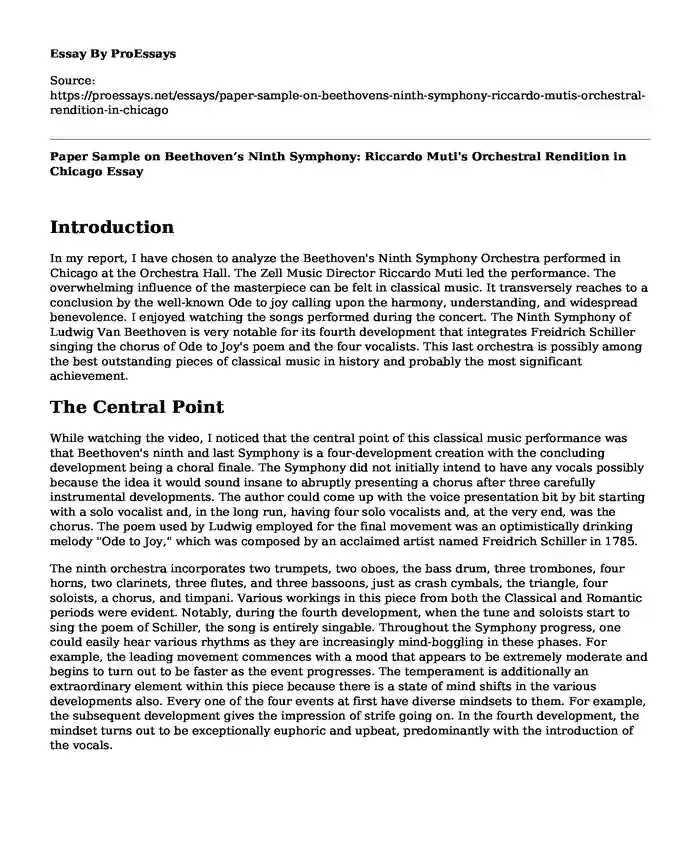Introduction
In my report, I have chosen to analyze the Beethoven's Ninth Symphony Orchestra performed in Chicago at the Orchestra Hall. The Zell Music Director Riccardo Muti led the performance. The overwhelming influence of the masterpiece can be felt in classical music. It transversely reaches to a conclusion by the well-known Ode to joy calling upon the harmony, understanding, and widespread benevolence. I enjoyed watching the songs performed during the concert. The Ninth Symphony of Ludwig Van Beethoven is very notable for its fourth development that integrates Freidrich Schiller singing the chorus of Ode to Joy's poem and the four vocalists. This last orchestra is possibly among the best outstanding pieces of classical music in history and probably the most significant achievement.
The Central Point
While watching the video, I noticed that the central point of this classical music performance was that Beethoven's ninth and last Symphony is a four-development creation with the concluding development being a choral finale. The Symphony did not initially intend to have any vocals possibly because the idea it would sound insane to abruptly presenting a chorus after three carefully instrumental developments. The author could come up with the voice presentation bit by bit starting with a solo vocalist and, in the long run, having four solo vocalists and, at the very end, was the chorus. The poem used by Ludwig employed for the final movement was an optimistically drinking melody "Ode to Joy," which was composed by an acclaimed artist named Freidrich Schiller in 1785.
The ninth orchestra incorporates two trumpets, two oboes, the bass drum, three trombones, four horns, two clarinets, three flutes, and three bassoons, just as crash cymbals, the triangle, four soloists, a chorus, and timpani. Various workings in this piece from both the Classical and Romantic periods were evident. Notably, during the fourth development, when the tune and soloists start to sing the poem of Schiller, the song is entirely singable. Throughout the Symphony progress, one could easily hear various rhythms as they are increasingly mind-boggling in these phases. For example, the leading movement commences with a mood that appears to be extremely moderate and begins to turn out to be faster as the event progresses. The temperament is additionally an extraordinary element within this piece because there is a state of mind shifts in the various developments also. Every one of the four events at first have diverse mindsets to them. For example, the subsequent development gives the impression of strife going on. In the fourth development, the mindset turns out to be exceptionally euphoric and upbeat, predominantly with the introduction of the vocals.
The Ninth Symphony of Beethoven
By and by, I appreciated tuning in to the ninth Symphony of Beethoven because there were such a significant number of changes in components, for example, the tune, concordance, beat, and state of mind. It is a piece that anybody could tune in to, and they would no doubt perceive in any event one of the four developments and never get exhausted because they would not recognize what they would hear straightaway. Likewise, I trust it is an astounding achievement for Beethoven to have the option to create and take an interest in the first execution of this piece, considering he was hard of hearing as of now. Beethoven is no ifs, ands or buts one of the most practiced authors of his time and one of the best. His last ensemble impeccably looks like the change from the Classical to the Romantic time frame and shows how incredibly hard he functioned in his calling.
Conclusion
In conclusion, I realized that one genre of music should not be linked to a single instrument. This came after I had listened to the performance of Beethoven's Ninth Symphony. I generally related the drums and string instruments with rock, yet, I discovered that it could likewise sound great when played in the performance of classical music. This was after I keenly watched the video. I was delighted watching this presentation since I loved that there did not need to be somebody with great hearing to entertain a crowd of people. The straightforward sound of each instrument made me move well in my seat. That is the thing that music is tied in with, involving the audience with the sound of every instrument. Notwithstanding his deafness, Beethoven led the piece himself. Towards the end, the crowd applauded fiercely, however, Beethoven was not aware until one of the soloists "culled him by the sleeve and guided his focus toward the applauding and waving caps and pieces of cloths at that point he turned to the crowd and bowed.
Work Cited
Csowebmaster. Chicago Symphony Orchestra. https://www.youtube.com/user/csowebmaster.
Cite this page
Paper Sample on Beethoven's Ninth Symphony: Riccardo Muti's Orchestral Rendition in Chicago. (2023, Sep 25). Retrieved from https://proessays.net/essays/paper-sample-on-beethovens-ninth-symphony-riccardo-mutis-orchestral-rendition-in-chicago
If you are the original author of this essay and no longer wish to have it published on the ProEssays website, please click below to request its removal:
- Analysing the Effects of Mass Media on the Development and Socialization of Children and Young Adults
- Essay Sample on Horror Movies
- Media Revolution in China Book Review Paper Example
- Movie Analysis Essay on The Greatest Movie Ever Sold
- The Jazz Age Essay
- Understanding Critical Commentary: Language Development & Analysis - Essay Sample
- Rennie Harris Pure Movement: Emphasizing Essence of Street Dance - Essay Sample







